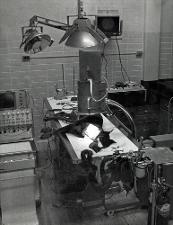| dc.coverage.spatial | College Station, Texas | en |
| dc.coverage.temporal | between 1970 and 1979 | en |
| dc.date.accessioned | 2017-08-24T22:05:20Z | |
| dc.date.available | 2017-08-24T22:05:20Z | |
| dc.identifier.uri | https://hdl.handle.net/1969.1/161783 | |
| dc.description | At the Heart Station a Doberman is on a procedure table. Writing on the photo or group of photos: 'Institute of Comparative Medicine. The Heart Station. "A&M has one of the few complete Heart Station in the Country". Making it possible for performing a cardia catheterization on a large dog. A tube is being inserted into the heart, measuring blood pressures and oxygen saturation in each chamber. The heart station is capable of performing angiocardiography of the heart. Dye is injected into the blood stream and is observed as it passes through the heart with the use of a fluoroscope. This is done to detect heart defects & obnormal structures of the heart.' Physical description: Black and white print (photograph) mounted 35x 27.5mm. | en |
| dc.description.abstract | The Institute of comparative Medicine was founded in 1972 as a colaborative effort between the Baylor University College of Medicine (BCM) and the College of Veterinary Medicine. The driving influence being the "One Medicine" (sometimes called "One Health") approach, expounded by Sir William Osler (1849-1919). The concept for the program was presented to Dean A.A. Price and the College Executive Committee in 1967. All were in favor and the planning began. The Institute was approved by the Board of Regents in 1972 and funded from state appropriations. Dr. William R. McCulloch was appointed Director in 1974 and Dr. Stephen W.J. Seager was named associate director. The Institute of Comparative Medicine or the Heart Station as it was sometimes called, served four primary functions: teaching, research, service, and continuing education. "A&M has one of the few complete Heart Station in the Country". Making it possible for performing a cardia catheterization on a large dog. A tube is being inserted into the heart, measuring blood pressures and oxygen saturation in each chamber. The heart station is capable of performing angiocardiography of the heart. Dye is injected into the blood stream and is observed as it passes through the heart with the use of a fluoroscope. This is done to detect heart defects & obnormal structures of the heart. | en |
| dc.relation.ispartof | College of Veterinary Medicine Image Collection | en |
| dc.rights | It is the user’s responsibility to secure permission from the copyright holders for publication or re-use of any materials. Permission must be obtained in writing prior to publication. Please contact the Medical Sciences Library for further information. | en |
| dc.subject | Medicine, Comparative | en |
| dc.subject | College of Medicine--Baylor University | en |
| dc.subject | Institute of Comparative Medicine (College of Veterinary Medicine) | en |
| dc.subject | Veterinary cardiology | en |
| dc.subject.mesh | Cardiac Catheterization | en |
| dc.subject.mesh | Angiocardiography | en |
| dc.subject.mesh | Heart | en |
| dc.subject.mesh | dogs | en |
| dc.title | The Heart Station, number 2 | en |
| dc.contributor.sponsor | College of Veterinary Medicine & Biomedical Sciences | |
| dc.type.material | Image | en |


